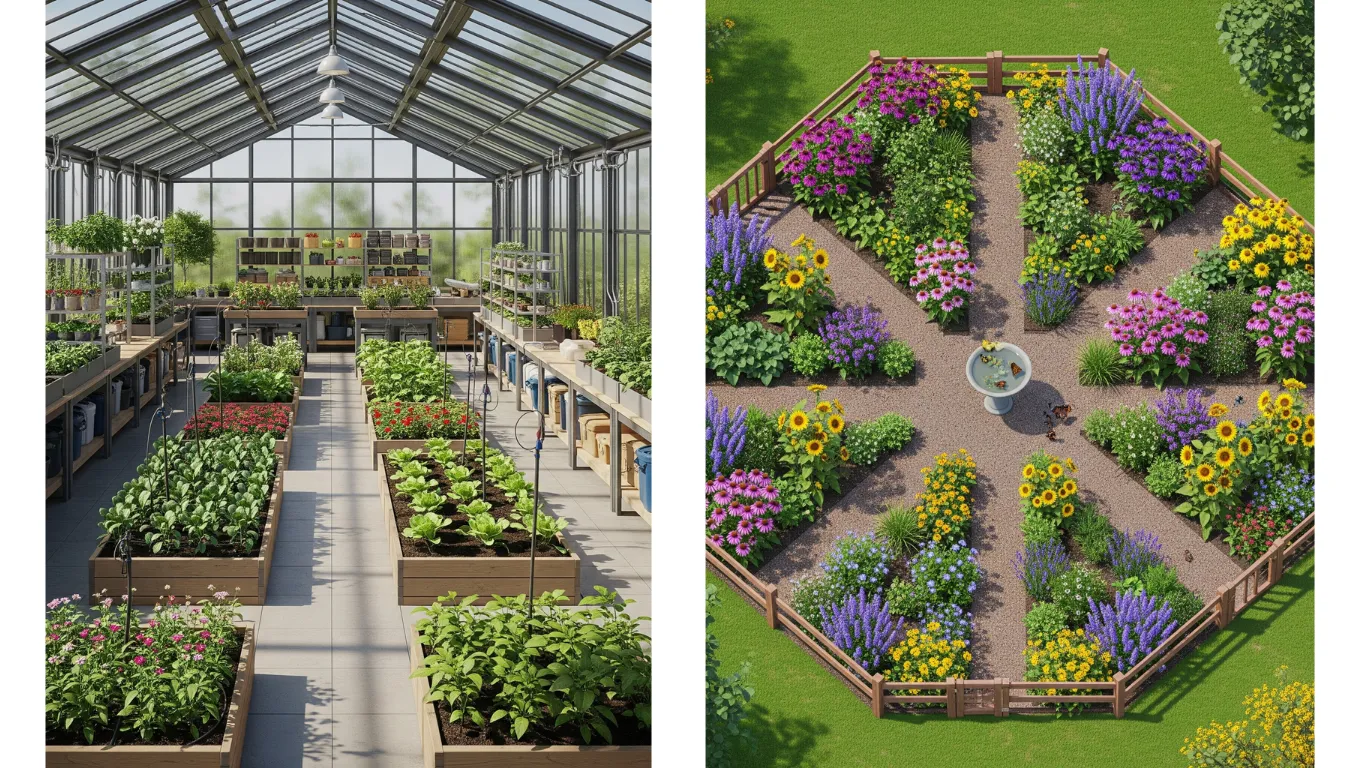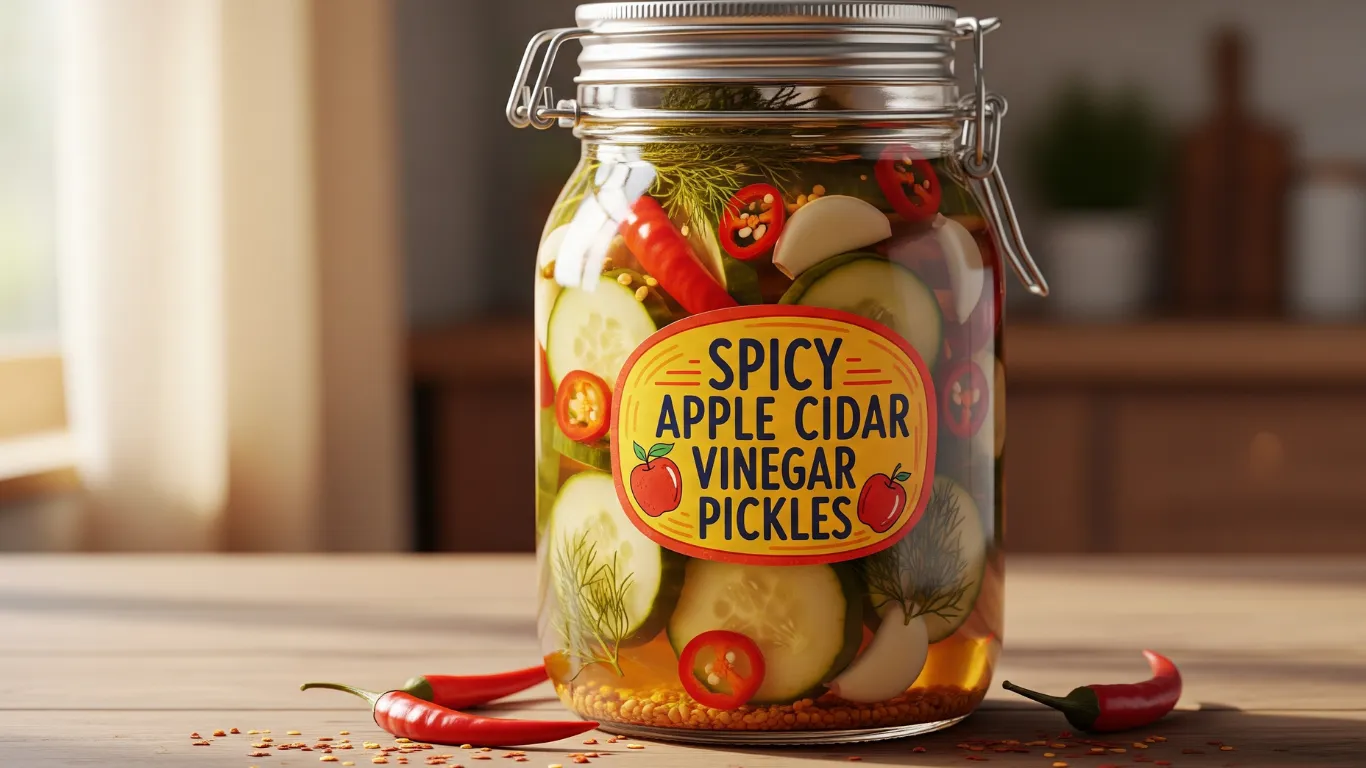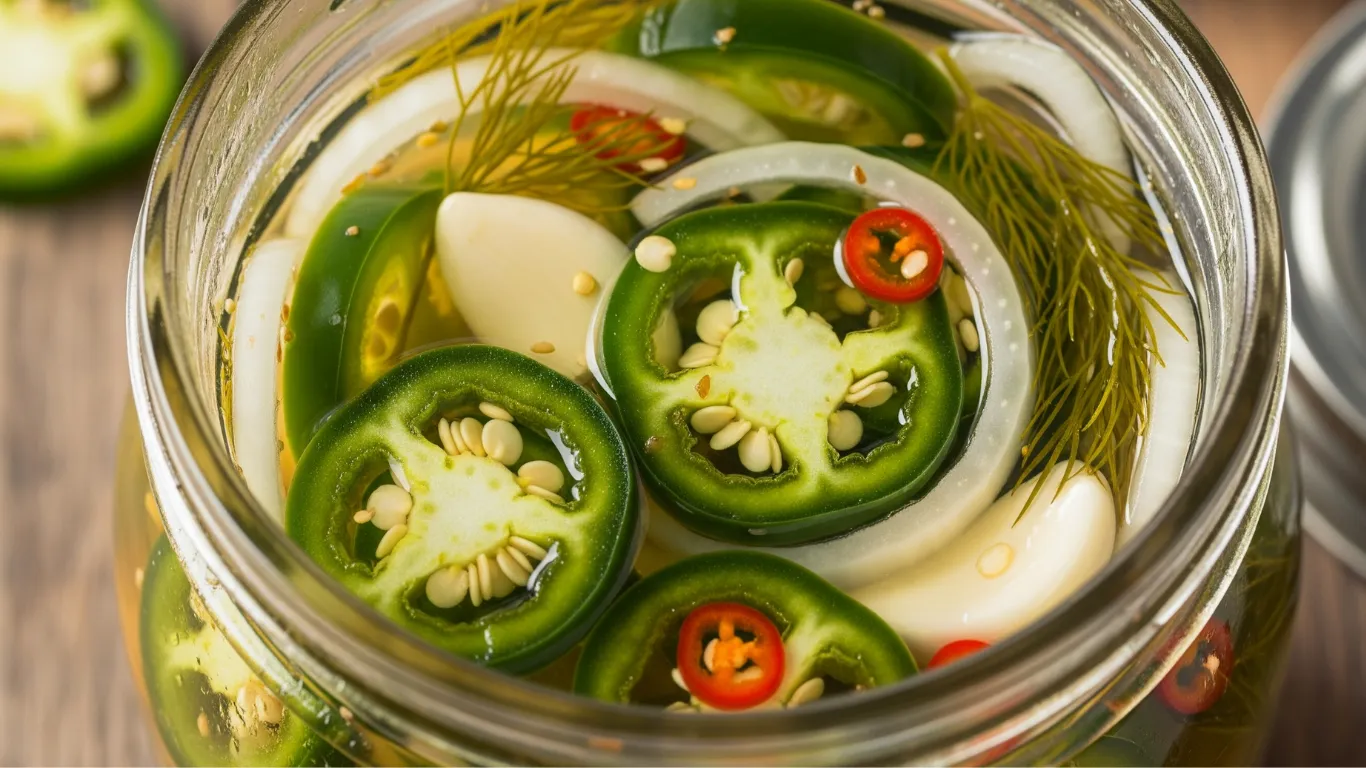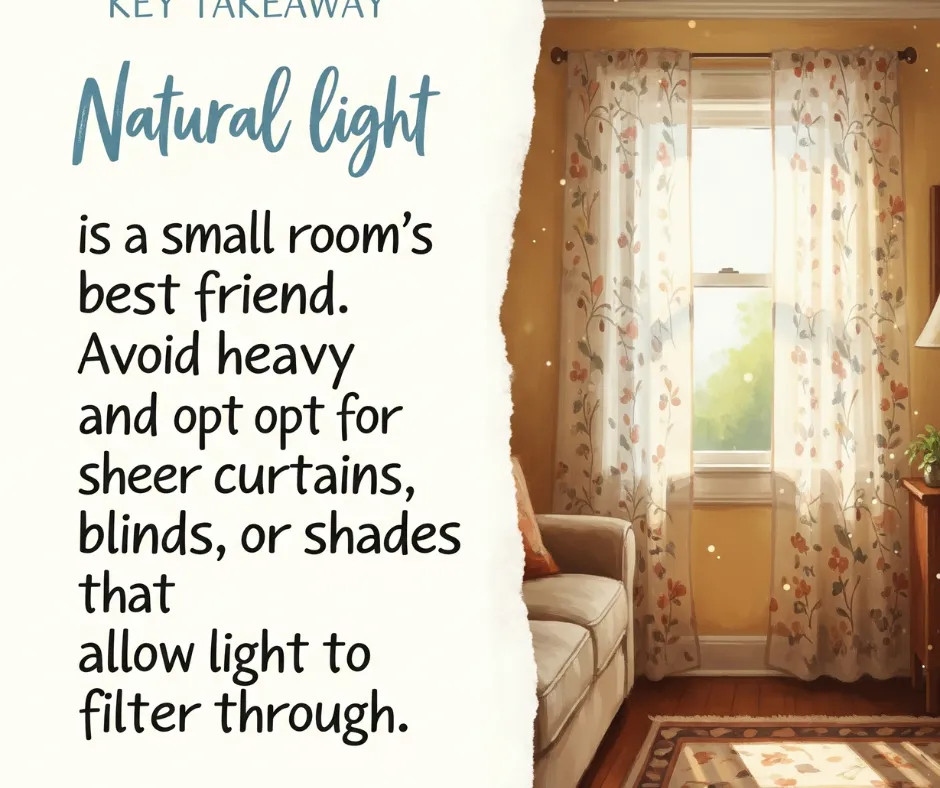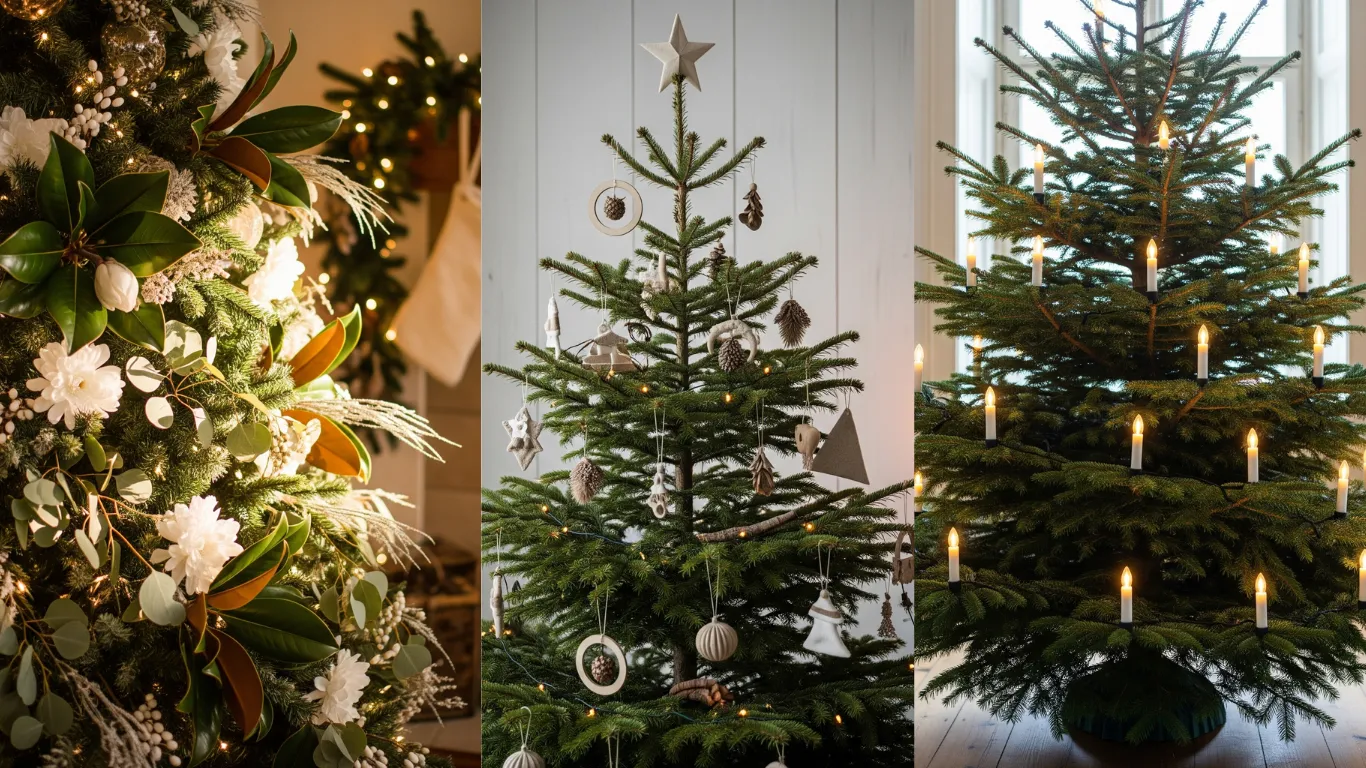Planting seeds is only one aspect of gardening; another is creating a beautiful and useful environment. A well-planned garden can improve your outside area, increase yield, and even make gardening more convenient. There is a garden layout that can work for you, regardless of how big your backyard is, how little your balcony is, or how small your urban patio is.
This post will discuss ten grow garden plan concepts that are simple to use, aesthetically pleasing, and useful for both novice and seasoned gardeners.
1. Raised Bed Garden Layout
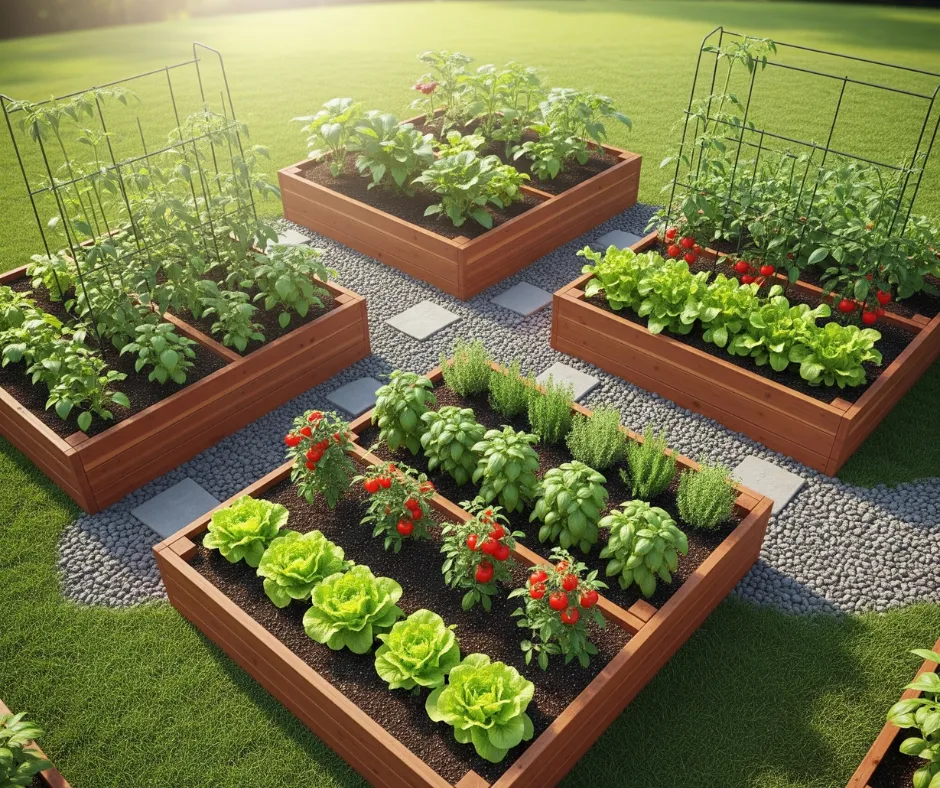
One of the most well-liked and effective plant-growing designs is the raised bed garden, which is particularly useful for novices or people with little outdoor space. Raised beds are elevated planting spaces that are usually constructed with metal, stone, or wood structures rather than planting directly in the ground. With their premium soil, these beds are perfect for cultivating flowers, vegetables, and herbs in a regulated setting.
Why Choose a Raised Bed Garden Layout?
The capacity of raised beds to immediately improve soil quality is one of their greatest benefits. A raised bed enables you to fill it with the ideal mixture of topsoil and compost, regardless of whether your backyard soil is rocky, clay-heavy, or lacking in nutrients. Better yields and healthier plants are the results of this.
Additionally, raised beds enhance drainage, avoiding issues like waterlogging and root rot that are typical of conventional in-ground gardens. Weed control is an additional advantage; weeds are much easier to control when you start with new soil and well-defined borders. Even pests like slugs and snails are deterred by the raised design.
Raised beds are revolutionary in terms of ergonomics. Particularly for elderly people or people with mobility impairments, the increased height makes gardening more comfortable by reducing bending and kneeling. Additionally, they enhance the visual appeal of your outdoor area by appearing tidy and well-organized.
Designing Your Raised Bed Layout
Location is crucial when creating a raised bed garden design. For convenient irrigation, pick a location that receives at least 6 to 8 hours of sunlight each day and is close to a water source. You can reach the center of the bed without going inside and compacting the soil thanks to the standard bed proportions of 3–4 feet broad by 6–8 feet long.
Due to its durability and safety for food cultivation, untreated wood, such as cedar, is a preferred choice for materials. If you prefer a more permanent construction, metal or stone frames are also excellent choices.
To avoid shading smaller crops like lettuce, carrots, or herbs, place taller plants like tomatoes, peppers, or trellised beans on the north side of the bed. To make upkeep and access easier, think about constructing walkways between several beds.
Best Crops and Maintenance Tips
Among the many plants that thrive in raised beds are herbs like parsley, rosemary, and basil, as well as vegetables like peppers, lettuce, carrots, and radishes. In addition to adding color, flowers like marigolds also keep dangerous pests away.
Fill your raised bed with a 50/50 mixture of compost and topsoil for best results, and replenish it every season to maintain nutrient balance. For effective watering, install a soaker hose or drip irrigation system. To keep the soil moist and prevent weed growth, mulch it.
2. Square Foot Garden Layout
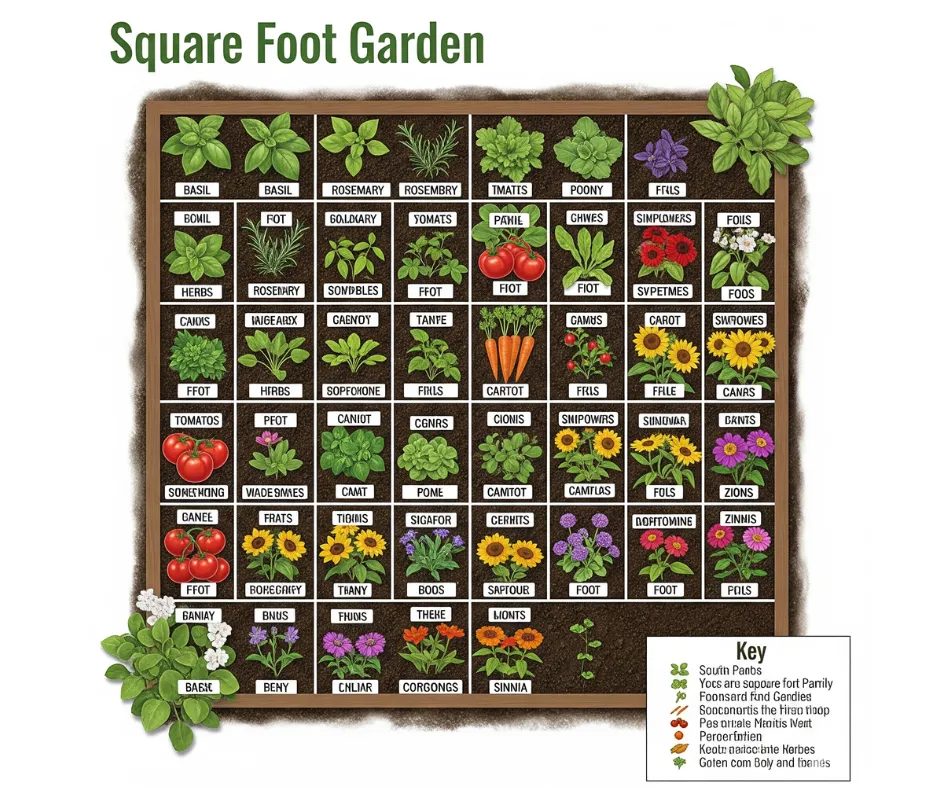
One of the most effective and approachable gardening designs is the square foot garden pattern. This design, which was made popular by Mel Bartholomew, divides a garden bed into uniformly sized, small portions (often one-foot squares) that are planted with various crops. It’s ideal for gardeners who are new to gardening, have hectic schedules, or have limited space.
Why Choose a Square Foot Garden Layout?
The efficiency of space is the main benefit of a square foot garden design. You may grow more plants in less space without packing your garden bed with too many plants by dividing it into equal squares. Because each square has its own crop, planting, harvesting, and planning are made simpler.
Because the plants are closely spaced, there is less space for weeds to develop, which further reduces weeding. Because you only concentrate on small, specific planting areas, it also saves water and fertilizer. Because it’s organized, manageable, and eliminates the element of guesswork involved in plant placement and spacing, beginners adore this method.
How to Design Your Square Foot Garden
Start with a raised bed that is 4 feet by 4 feet (or comparable in size), giving you 16 separate 1 foot squares. The bed can be divided into equal parts with wooden slats or string. For wholesome plant growth, fill it with premium soil that has been combined with compost.
Arrange crops according to their size:
One square: Cabbages, peppers, and tomatoes
4 per square: basil and lettuce
Beets and spinach, nine per square
16 carrots and radishes per square
To maintain soil fertility and minimize pests, rotate crops each season.
Best Plants for Square Foot Gardening
Leafy greens, herbs, root vegetables, and compact fruiting plants thrive in this layout. Companion planting (like tomatoes with basil or carrots with onions) works well and naturally reduces pests.
3. Vertical Garden Layout
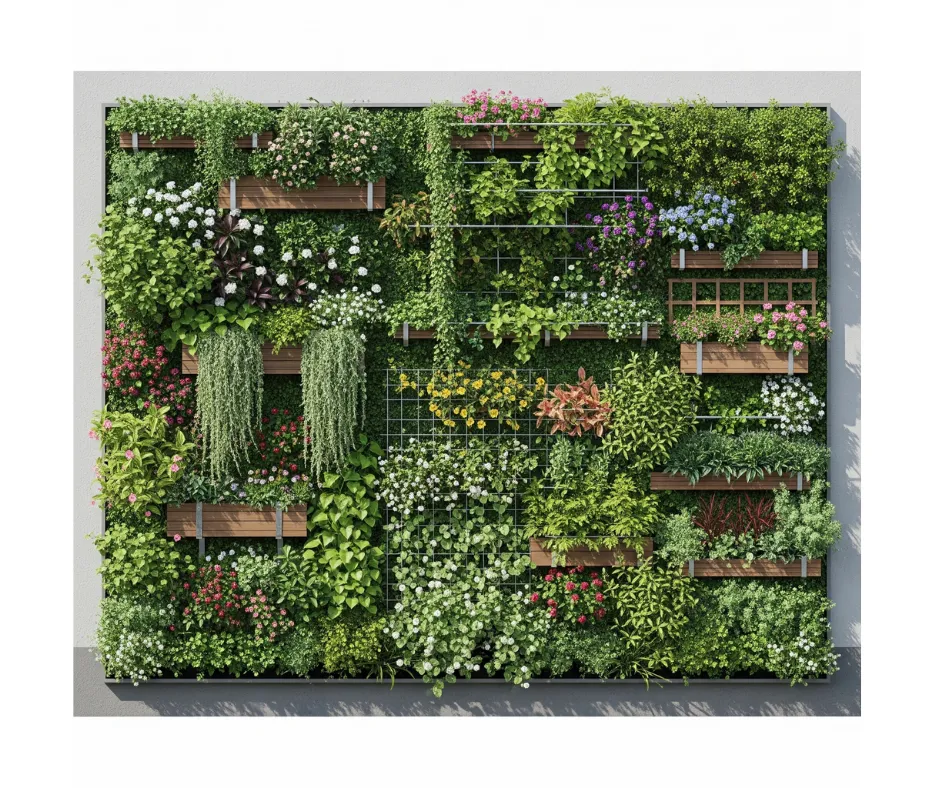
When you have little ground space, a vertical garden design is a clever and fashionable approach to cultivate plants. This arrangement uses walls, fences, or specially made structures to grow foliage upward rather than distributing it over the yard. For apartment dwellers, urban gardeners, or anybody else looking to make the most of their available space while enhancing the aesthetics of their indoor or outdoor space, this is a great option.
Why Choose a Vertical Garden Layout?
In addition to creating beautiful focal pieces, vertical gardens conserve precious floor space. They look great in courtyards, tiny patios, balconies, and even indoor areas. By increasing airflow around plants, this arrangement promotes their health and lowers the risk of pests and illnesses. Vertical gardens also serve as organic décor, bringing beauty and vitality to otherwise unutilized vertical areas.
Design and Planting Ideas
Wall-mounted planters, stacked shelves, trellises, hanging baskets, or even reclaimed materials like wooden pallets can all be used to construct a vertical garden. Select plants that grow well vertically, including compact herbs (parsley, mint, and basil), cascading flowers (petunias, ivy), and climbing vegetables (peas, cucumbers).
Choose a location for your vertical garden that receives plenty of sunlight and has easy access to water to ensure its success. To maintain plant health and ease upkeep, use lightweight soil and build a drip irrigation system.
4. Container Garden Layout

For gardeners with little outside space, renters, or anybody looking for a versatile way to cultivate plants, a container garden layout is a great option. This design grows a range of vegetables, herbs, flowers, and ornamental plants in pots, planters, or even reused containers rather than directly in the ground. It’s ideal for places where traditional gardens might not be feasible, including patios, balconies, rooftops, or little yards.
Why Choose a Container Garden Layout?
The flexibility of container gardening is unparalleled. Whenever you want, you can rearrange your area, move containers to get more sunlight, or shield plants from inclement weather. Compared to in-ground gardens, it also lessens pest problems, weed development, and soil quality. This arrangement enables urban gardeners or tenants to cultivate lovely flowers and fresh fruit without requiring permanent landscaping.
Design and Planting Tips
Select containers for your container garden that are the right size for each plant and have adequate drainage. To make a visually beautiful and useful arrangement, group containers according to the type of plant or color scheme. Containers are ideal for growing herbs, leafy greens, tomatoes, peppers, and even tiny fruit trees. Plants of various heights and textures should be mixed together for visual interest; taller plants should be placed in the back, while cascading varieties should be placed along the edges.
Because container gardens dry out more quickly than ground beds, it’s important to use lightweight soil mixtures and water them frequently. Adding rolling stands allows you complete control over the design of your garden by making heavy pots easy to move.
5. Companion Planting Layout
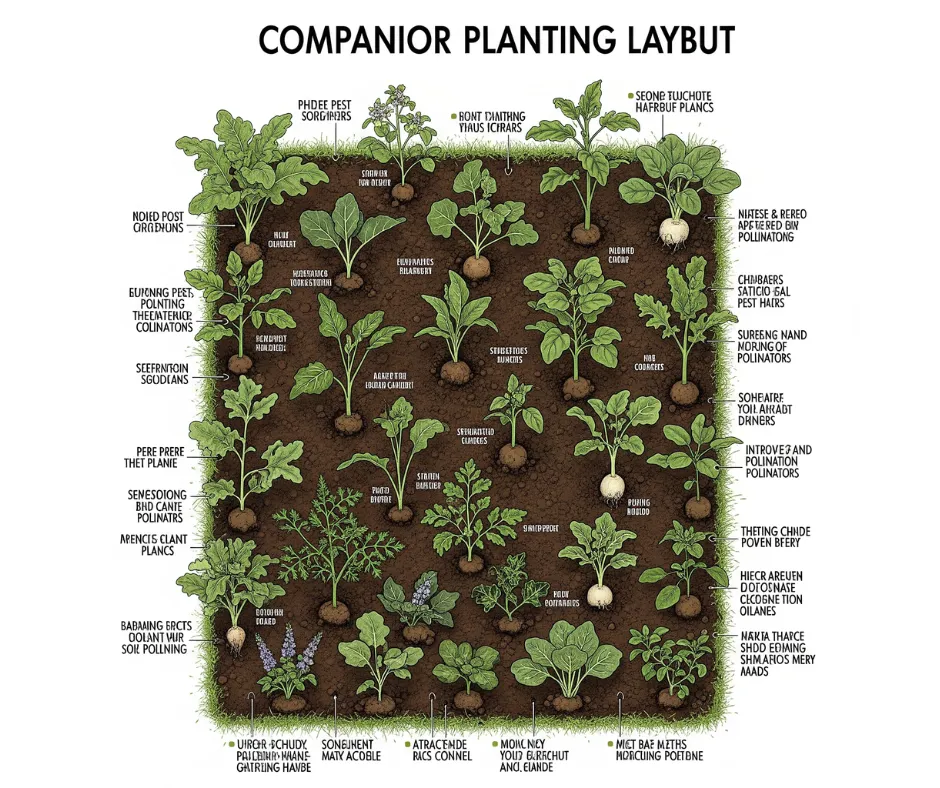
A clever and organic method of gardening is companion planting, which couples plants together to enhance growth, manage pests, and increase production. Companion planting emphasizes thoughtful placement where plants aid in one other’s growth rather than haphazardly planting crops. Both small backyard gardens and larger vegetable plots benefit from this centuries-old technique.
Why Choose Companion Planting?
- Companion planting has various advantages.
- Pest Control: Insects that damage other crops are naturally repelled by certain plants. Aphids and whiteflies are repelled, for instance, when basil is planted close to tomatoes.
- Improved Growth: Some plants improve soil quality or shade more sensitive crops, increasing yields
- Space Efficiency: By growing several crops in one location, companion planting enables you to maximize the amount of space in your garden.
- Biodiversity: It draws beneficial insects that aid with pollination and pest management, such as ladybugs and bees.
How to Design a Companion Planting Layout
Plants that grow well together should be grouped together first. Traditional pairings consist of: Basil with tomatoes: Pests are repelled and tomato flavor is enhanced by basil.
Corn + Beans + Squash (Three Sisters): Squash keeps moisture and inhibits weeds, while corn helps climbing beans.
Carrots + Onions: Onions protect the crop by keeping carrot flies away.
Arrange your arrangement in parts, avoiding known plant incompatibilities (such as onions and peas) and grouping beneficial pairings or groups together.
6. Herb Spiral Garden Layout
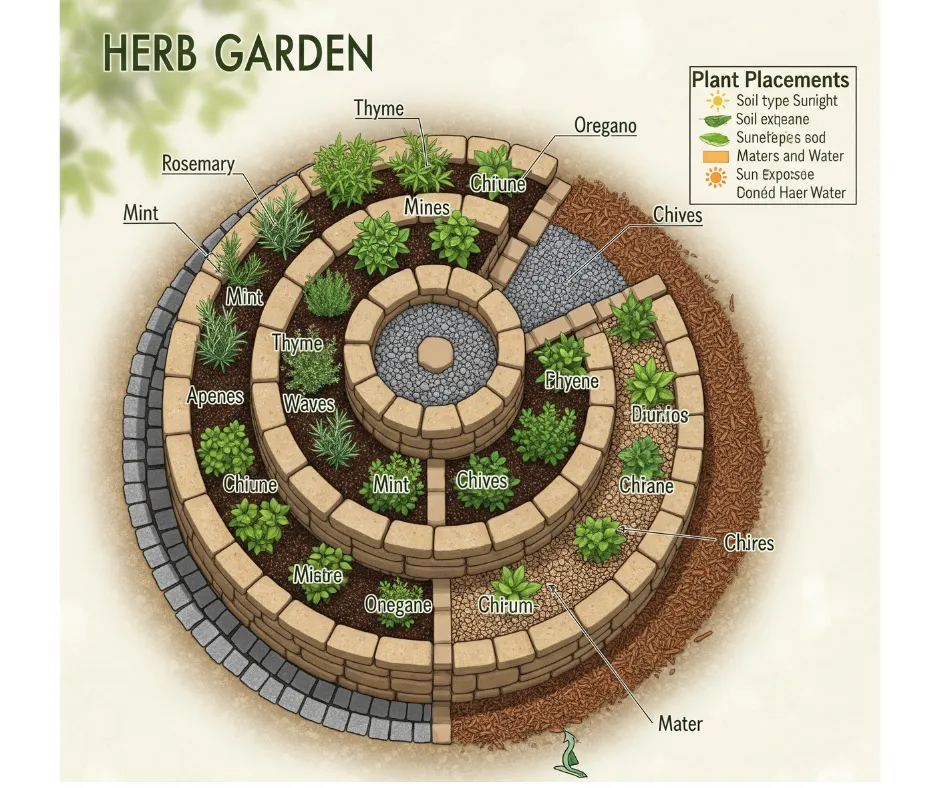
You can cultivate a variety of herbs in a single, small, spiral-shaped structure with an inventive and space-efficient herb spiral garden idea. The spiral shape, which may be constructed with wood, brick, or stone, produces many microclimates in a limited space, which makes it ideal for growing plants that demand varying amounts of water and sunlight.
Why Choose an Herb Spiral Garden Layout?
Different conditions are provided by the unusual spiral shape: the lower levels retain more moisture, making them suitable for mint and parsley, while the top is warm and dry, making it perfect for Mediterranean herbs like rosemary and thyme. This design makes excellent use of vertical space, which makes it a fantastic choice for patios, tiny gardens, and urban areas.
An herb spiral can be a focal point in your garden and is aesthetically pleasing in addition to being useful. It maintains all of your favorite herbs in one handy, accessible spot and eliminates the need for separate garden beds.
How to Build an Herb Spiral
To make one, form a spiral out of bricks, stones, or logs, making the base wide and the top small. Fill the structure with compost and nutrient-rich soil. Plant sun-loving herbs like sage and basil in the center, moisture-loving herbs like mint and chives toward the base, and drought-tolerant herbs like oregano at the top.
7. Cottage Garden Layout
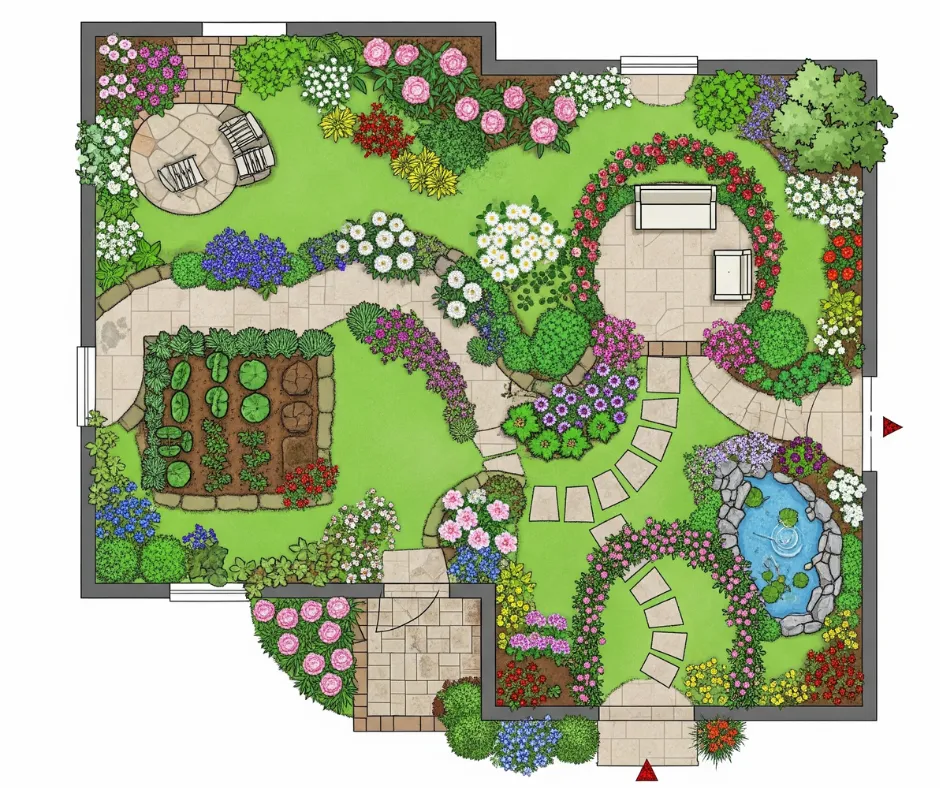
A cottage garden design blends elegance, practicality, and a dash of wildness in a timeless and charming way. A cottage garden emphasizes a natural and flowing design with a variety of flowers, herbs, vegetables, and shrubs, in contrast to formal gardens with rigid symmetry. Its casual appearance, which creates a warm and lively outdoor atmosphere, is what makes it so appealing.
Why Choose a Cottage Garden Layout?
The design of the cottage garden creates a lively, rich area while highlighting biodiversity. It is ideal for attracting pollinators, such as bees and butterflies, which encourages plant growth. Because it allows gardeners to combine ornamental and edible plants, this arrangement is both aesthetically pleasing and practical. Aromatic daisies and roses can be enjoyed with vegetables, herbs, and fruit-bearing bushes.
Another advantage is flexibility. Cottage gardens are perfect for gardeners who want a more relaxed and creative style because they don’t need to be exactly aligned.
Design Tips for a Cottage Garden
To improve the garden’s organic flow, start with curving walkways or stepping stones. Plant a variety of annuals and perennials in layers, with low-growing herbs in the center, medium-height plants like foxgloves or lavender in the middle, and taller shrubs and climbing roses in the back. or flowers along walkways, such as pansies and thyme. For extra charm, include rustic accents like ornate birdhouses, old benches, or wooden trellises.
8. Greenhouse Garden Layout
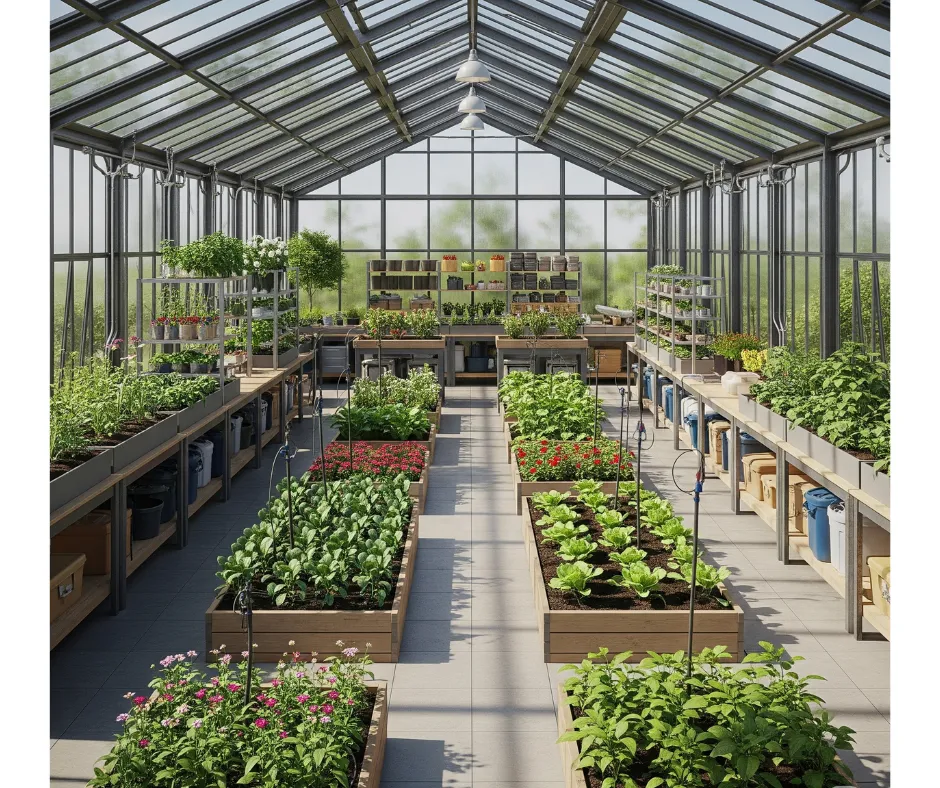
Regardless of the weather, a greenhouse garden layout is made to help you grow plants all year long. You can increase the length of your growing season and grow a variety of plants, from exotic flowers and seedlings to vegetables and herbs, by using a protected, climate-controlled structure. A carefully thought-out arrangement makes gardening more effective, guarantees enough airflow, and maximizes available area.
Why Choose a Greenhouse Garden Layout?
A steady environment with controllable light, humidity, and temperature is produced by greenhouses. As a result, you can plant crops earlier in the spring, harvest them later in the winter, and even try out uncommon or tropical plants that might not do well outside. A greenhouse also shields your plants from pests, illnesses, and inclement weather, which promotes healthier and more fruitful development.
Design Tips for a Greenhouse Garden
Plants should be arranged according to their requirements for temperature and light while designing your arrangement. While tiny herbs, lettuce, or flowers can be arranged near the front for convenience, taller plants, such as tomatoes or cucumbers, should be placed along the back or sides. To save room and boost growth capacity, use tiered racks, hanging planters, or vertical shelves. To avoid overheating, install walkways for convenient mobility and make sure there is adequate ventilation with fans or vents.
9. Pollinator-Friendly Garden Layout

The goal of a pollinator-friendly garden design is to draw in and encourage beneficial insects such as hummingbirds, butterflies, bees, and other pollinators. These animals are essential to the reproduction of plants, promoting the growth of fruits, vegetables, and flowers. You can increase crop yields, encourage biodiversity, and support a more robust ecosystem by designing a garden layout that caters to their needs.
Why Choose a Pollinator-Friendly Garden Layout?
Pollinators are essential to both environmental balance and food production. In addition to making your garden look better, a pollinator-friendly design gives endangered species a safe haven. It guarantees healthier, more fruitful plants and lessens the need for chemical pollination.
Design Tips for Pollinator Gardens
Select a variety of native blooming plants that bloom all year long when designing your layout to provide pollinators with food sources throughout the year. Plants should be grouped together to facilitate pollinators’ finding them. Incorporate a range of flower colors and forms to draw in a variety of species.
For cover and nesting, include trees, shrubs, and flowering vines. A birdbath or modest water feature can supply vital hydration. Chemical pesticides should be avoided since they can damage pollinators. Use natural or organic pest control techniques instead.
10. Zen Garden Layout
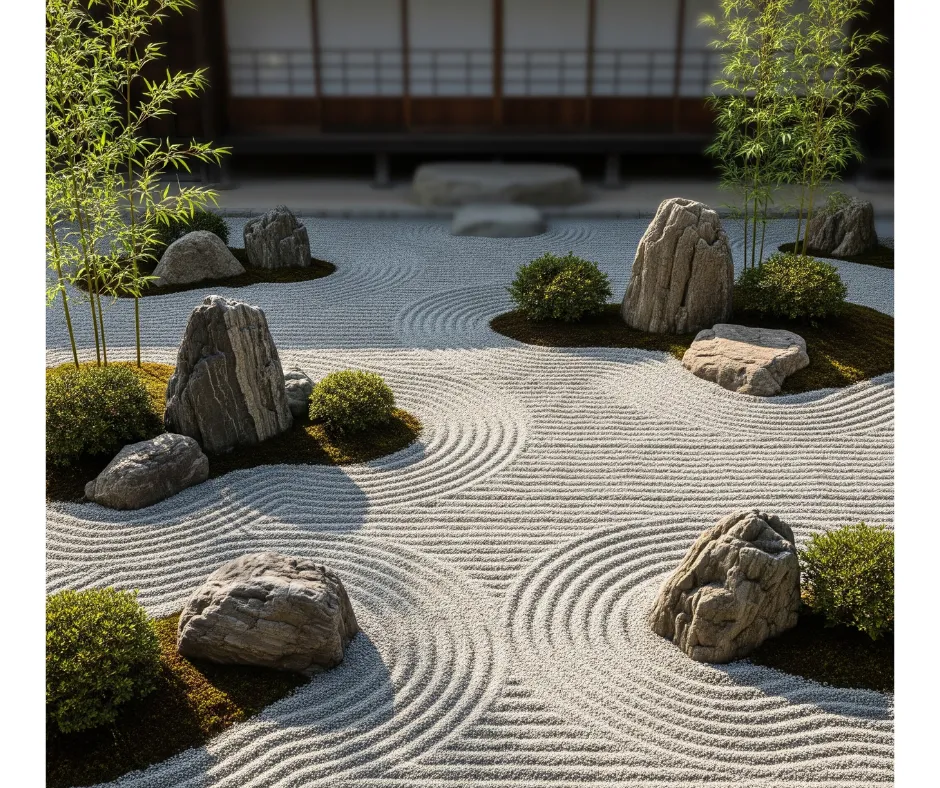
The purpose of a Zen garden arrangement is to encourage simplicity, attention, and relaxation. These gardens, which draw inspiration from Japanese culture, emphasize natural features and minimalism to create a tranquil area that promotes introspection and meditation. Zen gardens use rocks, sand, gravel, and strategically placed plants to symbolize balance and harmony rather than vibrant flowers and lush vegetation.
Why Choose a Zen Garden Layout?
Zen gardens are ideal for tiny outdoor or even inside spaces because they are minimal maintenance and visually soothing. They are perfect for people looking for a calm and clutter-free space since they place more emphasis on textures, open areas, and clean lines than on vibrant colors. In addition to requiring less upkeep than traditional gardens, the straightforward design makes it simpler to maintain.
Design Tips for a Zen Garden
To symbolize water and flow, begin with a base of sand or gravel. Make use of big boulders or stones to create symbolic mountains and focal points. To encourage attention and produce a calming visual effect, incorporate raked patterns into the sand. Without overpowering the simplicity, add little touches of greenery like bamboo, moss, or a single bonsai. Lanterns, water features, or tiny wooden bridges can all contribute to the serene atmosphere.
Maintain a simple design with balanced symmetry and open areas. Steer clear of crowded and concentrate on designing an area that encourages rest and meditation.
General Tips for Successful Garden Layouts
- Plan Ahead: Take into account water availability, soil composition, and sunlight.
- Select the Correct Plants: Choose plants that are appropriate for the soil and climate in your area.
- Consider Pathways: Provide simple access for harvesting and maintenance.
- Incorporate Aesthetic Elements: For aesthetic appeal, add benches, trellises, or ornamental stones.
FAQs About Garden Layouts
1. Which garden layout is best for beginners?
Because it is simple to set up, takes little upkeep, and can be adapted to various settings, a raised bed or container garden is ideal for novices.
2. What is the most space-efficient garden layout?
Due to their extreme space efficiency, square foot and vertical gardening are perfect for balconies, patios, and small yards.
3. How do I plan my garden layout?
Decide which plants you want to grow first, measure your area, and determine the patterns of sunlight. Make a simple plan by classifying plants according to their requirements for water and sunlight.
4. Can I combine different garden layout ideas?
Of course! For optimal effectiveness, many gardeners mix container gardening with vertical designs or raised beds with companion planting.
5. Do I need special soil for raised beds or container gardens?
Yes. Use a mix of garden soil, compost, and organic matter for better drainage and nutrient availability.
6. How often should I rotate crops?
Rotate your vegetable crops every year to keep soil nutrients from being depleted and to cut down on pests and diseases.
7. What’s the easiest plant to start with?
Vegetables like lettuce and radishes or herbs like parsley, mint, and basil are suitable for beginners.
8. How can I make my garden low-maintenance?
To minimize weeding, use mulch to retain moisture, plant native plants, set up drip irrigation, and choose raised beds.
9. Can I create a garden layout indoors?
Indeed. For apartment dwellers, vertical gardens with grow lights or indoor container gardening are great choices.
10. How do I attract pollinators to my garden?
A pollinator-friendly habitat can be created by adding a water source, avoiding chemical pesticides, and planting a variety of flowering plants.
Conclusion
Designing the ideal garden layout involves more than simply aesthetics; it also involves efficiency, practicality, and individual fulfillment. There is a scheme for every space and gardener, whether you like the innovative vertical design, the charming cottage garden, or the structured appearance of square foot gardening.
Your garden will quickly transform from a pastime to your own private haven if you start modest and try out various designs.
